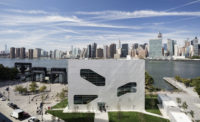 |
| Image courtesy NYC Dept. of Housing, Preservation & Development |
In Queens, an industrial area is being transformed into the Hunters Point mixed-use district. Steven Holl has been commissioned to design a new library for the neighborhood. |

Public libraries across the country are cutting employees and closing facilities, but the one that serves the borough of Queens, New York, is taking an opposite tack: It’s planning to open one of its largest branches to date, and it’s hired architect Steven Holl to design it.
The city announced in July that it had chosen Holl to design the 20,000-square-foot facility, which will sit by the East River, across from the United Nations complex. The $21 million project, which is set to open in 2013, will break ground next summer. A schematic design will be unveiled in November.
The Hunters Point neighborhood, where the library will be built, has undergone a major transformation since the 1990s. The former rail-yard now features a half-dozen residential high-rises, plus a public school and parkland. Four new apartment towers, a second school, and more parks are planned for a nearby parcel.
The library is expected to offer shelving for 85,000 books and DVDs, as well as a performance space and offices. It also will have slightly more room for community meetings than other facilities do, up from 75 seats to possibly 100, says Peter Magnani, a library director. Also on the site will be an information kiosk for Gantry Plaza State Park, located next door.
“This is a really important building for us from a public-relations perspective,” since it will be visible from so many high-traffic roads, like the FDR Drive and the Queensboro Bridge, Magnani says. “The message it will send is that our library is a beacon of knowledge.”
The Hunters Point library, which will be the 63rd in Queens, will serve a borough that seems to take reading seriously. With 23 million items loaned a year, the library system is, its officials say, the busiest in America. (In New York, the Queens Library operates separately from the New York Public Library, which serves Manhattan, the Bronx and Staten Island, and the Brooklyn Public Library, which covers Brooklyn.)
Holl, who is based in New York, has designed a smattering of projects there, like the Higgins Hall Center, a glass-walled 22,500-square-foot wing completed in 2005 that connects two architecture school buildings at Brooklyn’s Pratt Institute.
More recently, the firm designed the Campbell Sports Center for Columbia University, where Holl is a tenured architecture professor. The planned five-story, 48,000-square-foot complex, which will abut Baker Field where Columbia’s football team plays, is to feature offices, and auditorium and a hospitality space, though its design is a work in progress.
The Queens library would be the Holl’s first public project. Because funding will come from public sources, the firm’s selection was made by a city agency, the Department of Design and Construction, which picked Holl from among a short list of eight candidates. Those pre-screened candidates participate in the agency’s six-year-old Design and Construction Excellence program, which encourages creative public-works projects.
For architect Chris McVoy, senior partner at Steven Holl Architects, New York’s decision to boost library service while similar institutions reduce it speaks to a larger point: The Internet may not be as detrimental to physical texts as first thought. “A decade ago people were predicting the death of books,” he adds, “and we have found the opposite to be the case.”



Post a comment to this article
Report Abusive Comment